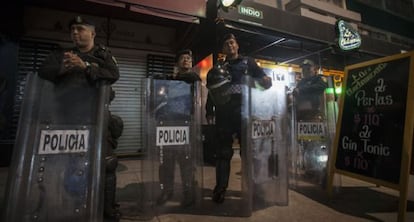Violence on the rise in Mexico City, as armed men hold up restaurant
The capital, once a safe haven, is experiencing its highest homicide rate in 17 years


In the morning, a body was found hanging from a bridge in Iztapalapa. In the afternoon, armed men burst into a popular restaurant in La Roma. Two hits on the same day – on Monday – in two completely different areas of Mexico City. The first took place in one of the most impoverished neighborhoods, and the second in one of the most upscale quarters of the city, illustrating how the security apparatus in the Mexican capital is failing. This huge urban sprawl of nine million residents is currently grappling with its worst spike in violence in the last 17 years.
The body was found in the early morning hours in the neighborhood of Lomas de Zaragoza, one of the toughest areas in Iztapalapa, a borough on the border with Mexico State. The victim’s hands were tied behind his back, his body wrapped up in white sheets, and his face was covered with a black mask. A group of firefighters took him down from the bridge. Mexico City’s attorney general confirmed that he was a 30 year-old man and that his body showed signs of torture and had two bullet wounds to the head. The authorities also found a card with a message for the supposed rival gang.
A series of tragic narco-style incidents have shaken up Mexico City over the last few months
This kind of scene, frequent during the drug traffickers’ peak years in Mexico, are no longer common in the capital, a city that was considered an oasis of security even during the worst years of narco-terror under the Felipe Calderón administration (2006-2012). Although the local government continues to deny the presence of organized crime in the area, the image of the idyllic refuge city is gradually crumbling.
A series of tragic narco-style incidents have shaken up Mexico City over the last few months. In May, a group of armed men rushed into the attorney general’s office building and, guns blazing, freed an alleged boss of the cartel, Jalisco Nueva Generación. In June, the owner of a bar in the upscale neighborhood of Condesa was shot dead while getting out of his car in front of his place of business. The numbers, moreover, clearly show that the capital is experiencing its worst bout of homicides in the last 17 years. According to the country’s National Statistics Institute and the Mexican Interior Ministry, there were 1,147 cases by August of this year.
“It’s less and less safe, and it makes you think that the best thing would be to hire private armed security contractors,” says Israel Colón, the manager of the restaurant Belmondo, a fashionable local spot in the ritzy neighborhood of La Roma. Five armed men burst into his restaurant in the afternoon. In less than five minutes, they had taken wallets and cellphones from 25 customers, before fleeing in a white van down Tabasco Street. “It is not the first time they’ve robbed here. Last week it was a neighbor’s motorcycle. It’s a very dark street,” Colón says.
Despite the fact that the president and attorney general deny it, there is organized crime, extortion, turf wars and kidnappings”
About 200 meters from that dark street is Álvaro Obregón Avenue, one of the main commercial streets and a hub for sophisticated entertainment: boutique hotels, restaurants serving organic food, designer stores... The mirror image of any neighborhood in any big Western capital that aspires to the bohemian style. The civic organization, Alto el Secuestro, says the cartels’ messengers are walking around those very same streets extorting businessmen and shopkeepers. “In Mexico City, despite the fact that the president and attorney general deny it, there is organized crime, there is extortion, turf wars and kidnappings,” Isabel Miranda, the group’s spokeswoman, told a Mexican news outlet.
Iztapalapa, one of the boroughs on the outskirts of the city and one of its poorest and most populated areas, with almost two million residents, and Cuauhtémoc, the historic heart of the capital where less than half-a-million people live, represents a cross-section of where the violence is spreading. These two areas have the highest crime rates in a city where, according to the attorney general, the police open 500 new cases every day on average.
English version by Dyane Jean Francois.
Tu suscripción se está usando en otro dispositivo
¿Quieres añadir otro usuario a tu suscripción?
Si continúas leyendo en este dispositivo, no se podrá leer en el otro.
FlechaTu suscripción se está usando en otro dispositivo y solo puedes acceder a EL PAÍS desde un dispositivo a la vez.
Si quieres compartir tu cuenta, cambia tu suscripción a la modalidad Premium, así podrás añadir otro usuario. Cada uno accederá con su propia cuenta de email, lo que os permitirá personalizar vuestra experiencia en EL PAÍS.
¿Tienes una suscripción de empresa? Accede aquí para contratar más cuentas.
En el caso de no saber quién está usando tu cuenta, te recomendamos cambiar tu contraseña aquí.
Si decides continuar compartiendo tu cuenta, este mensaje se mostrará en tu dispositivo y en el de la otra persona que está usando tu cuenta de forma indefinida, afectando a tu experiencia de lectura. Puedes consultar aquí los términos y condiciones de la suscripción digital.








































